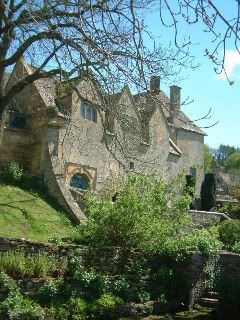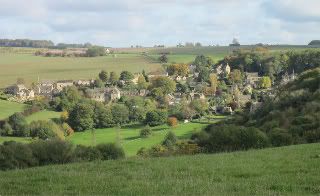A Cotswolds Ghost Story
 A Lonely Cotswolds Village
A Lonely Cotswolds Village
Snowshill is one of the loneliest and most unspoilt villages in the Cotswolds (a range of hills in south-west England). Its manor was owned by Winchcombe Abbey from 821 until the dissolution of the monasteries in 1539, when it passed to the Crown, and was given to King Henry VIII’s wife Katherine Parr, as a gift. Subsequently the house had numerous owners and tenants and underwent many modifications and additions. The main part of the house dates from around 1500, and was altered and extended in the seventeenth century. By 1919 Snowshill Manor was a semi-derelict farm. It was then that it was bought and restored by a man named Charles Wade.
Charles Paget Wade was an architect, artist-craftsman, collector and poet from Yoxford in Suffolk, who inherited sugar estates in the West Indies from his father. He had been employed as an architect with the firm of Parker & Unwin before serving with the army in France during the First World War.
It was whilst in the army that Wade saw an advertisement for the sale of Snowshill Manor in Country Life and the building and its rural Cotswolds setting appealed to him immediately. When he visited the Cotswolds in February 1919, Wade found the house in a rundown state amid a forest of nettles and thistles. He undertook a complete restoration of the house and garden, preserving as much of the old panelling and stonework as he could.
There were no modern additions or alterations at the Manor and Wade deliberately disregarded the use of electricity and modern conveniences, preferring the subdued and atmospheric lighting of oil lamps and candles. He then commenced filling it with his extraordinary collection of objets d’art, mechanical oddities, extraordinary clocks, bicycles, children’s toys and many other more bizarre items which he’d collected from various places around Britain.
Wade did not actually live in the manor house itself, but the old priest’s house in the courtyard. This small house, a priest’s lodgings in monastic times, is the cottage to the west of the Manor House, and had become a bake house / farm building when Wade bought Snowshill. Wade himself would add a touch of drama to the already unique atmosphere by materialising noiselessly from a dark corner of a room or from one of the numerous secret doors and passageways, to startle the guests.
Wade was extremely fond of dressing up using old costumes from amongst his vast collection, and visitors to his strange Cotswolds manor house, including John Betjeman, Virginia Woolf, Graham Greene and J.B. Priestley, were often persuaded to perform amateur dramatics in ‘Dragon’, one of the rooms in the manor house, or in the garden. J. B. Priestly described Wade as: ‘My eccentric, but charming friend of the fantastic manor house.’

Snowshill, Cotswolds
The names of the rooms in the house were chosen by Wade, and usually bear some relation to their contents, decoration, or their position in the house. So there are names like ‘Seventh Heaven’ on the top floor, ‘Meridian’ in the centre of the house, ‘Dragon’ – named after the roaring fire that Wade would usually have burning in what was probably the great fireplace of the medieval hall, and ‘Hundred Wheels’ containing objects mainly connected with transport. The ‘Green Room’ contains an incredible collection of twenty-six suits of Japanese Samurai armour, dating from the seventeenth to nineteenth centuries, gathered from various parts of England between 1940 and 1945.
Magic and Alchemy
Wade seems to have had a profound interest in magic and alchemy. In a private room at the top of his Cotswold manor house known as ‘The Witch’s Garret’ there was once a collection of objects connected with witchcraft, and the floor and one wall were (and still are?) decorated with various magical symbols. When the Manor was given to the National Trust this strange collection of magical objects was loaned to the Museum of Witchcraft, formerly at Bourton-on-the-Water in the Cotswolds, now at Boscastle in Cornwall. Amongst the items the Museum still has is a large oak magician’s chest, possibly from the 17th century.
Unfortunately this was badly damaged in a flood in 2004, and only the wooden carvings, including female figures, green men & horned god masks, survive. Nothing is mentioned of these occult items in the National Trust’s descriptions of Wade, the Manor House and his odd collection. Wade spent lots of time in the manor house organising and restoring his incredible collection and, by the time he handed it and the Manor over to the National Trust in 1951, he had amassed 22,000 items, plus a 2000 piece costume collection. In giving the collection to the National Trust his hope was that people would learn to value quality craftsmanship from contact with these objects, each endowed with the spirit of the craftsman and the era in which it was created.
Pages: 1 2




